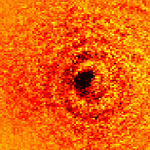
Beckham's curling free kicks have become legendary in the world of sport. Image: fstockfoto/Shutterstock
The perfect soccer ball kicking formula has been calculated.
David Beckham may not be appearing in the 2012 London Olympics, but his teammates can rest easy. Physics students from the University of Leicester in the UK were on the case and have determined the optimum way of kicking a soccer ball if you want to bend it into the goal.
Other studies have suggested that physics also influences the types of clothing that the soccer (football) players should be wearing and the effects of playing at high altitudes on their game. An article that discussed a new design of ball, which was used in the 2010 World Cup, made author Jasmine Sandhu consider how Beckham’s kicking technique could be affected by physics.
The new design used 3D moulding on the panels to produce a more rounded ball, which would affect the spin. “This prompted us to examine how footballers use spin on the ball, and the factors which influence how much the path of the ball would bend,” she says.
Sandhu and her colleagues have outlined a formula that explains how much the ball will curve if a player puts spin on it in their paper, published in the University of Leicester’s Journal of Special Physics Topics. When the ball spins in the air, the Magnus force acts on it and causes it to curl sideways from the direction it was originally kicked.
They found the distance that the ball bends (D) as a result of the Magnus force is related to the ball’s radius (R), it’s angular velocity (ω), it’s velocity through the air (v), it’s mass (m), the distance travelled by the ball in the direction it was kicked (x) and the density of the air (Ï).
So if a player standing 15 metres from the goal kicked the ball so that it was travelling at a velocity of 35 metres per second, with an angular velocity of 10 revolutions per second, it would bend five metres towards the goal.
“These findings made me more aware of how I can use spin to bend the ball in a game of football,” Sandhu says. “In addition, this research is also relevant to other sports, such as tennis, which shows that physics definitely gives you the edge!”
However, to put this theory into practice during a match, a player would need to bring a tape measure to the pitch and have a good idea of their own kicking abilities.
Source: The University of Leicester






